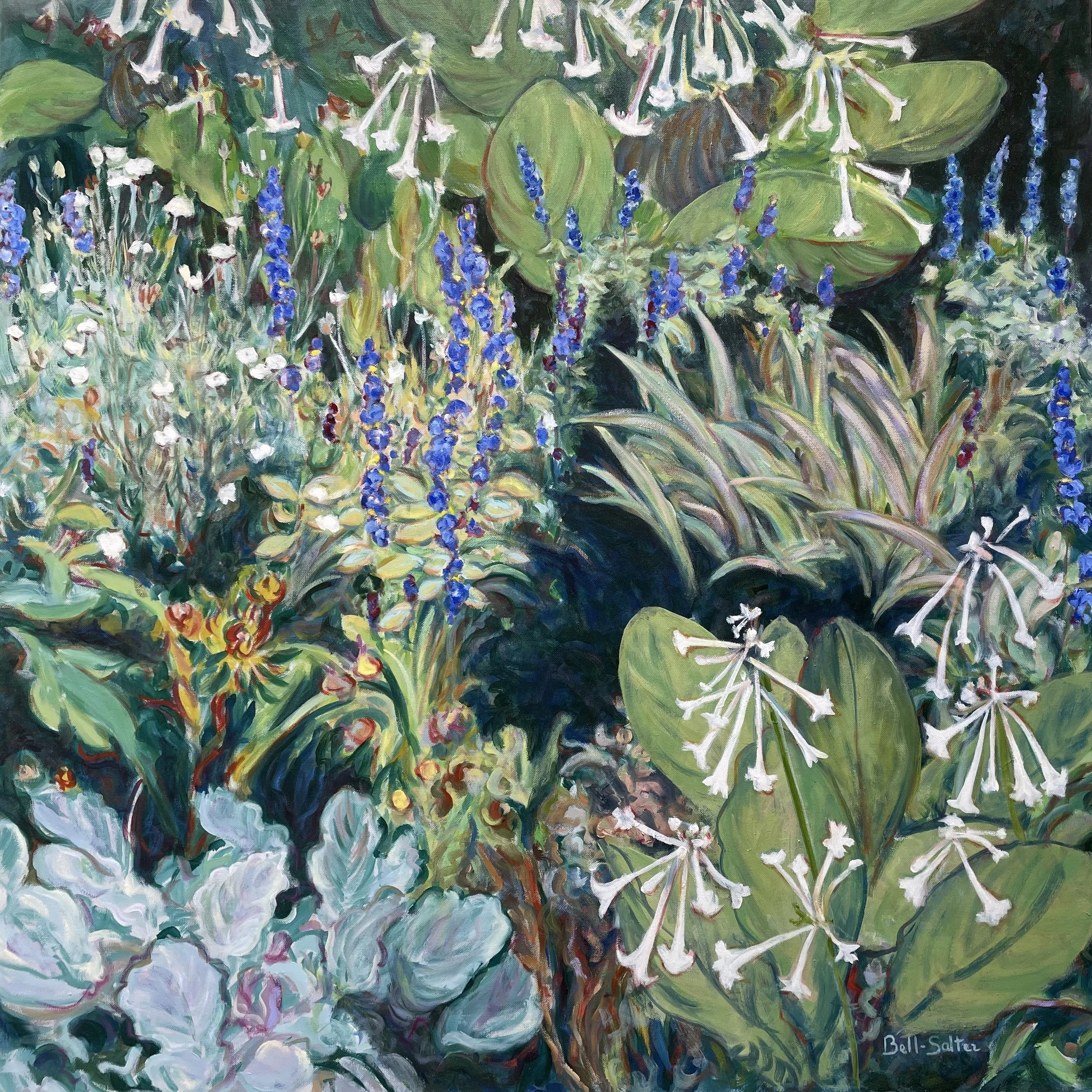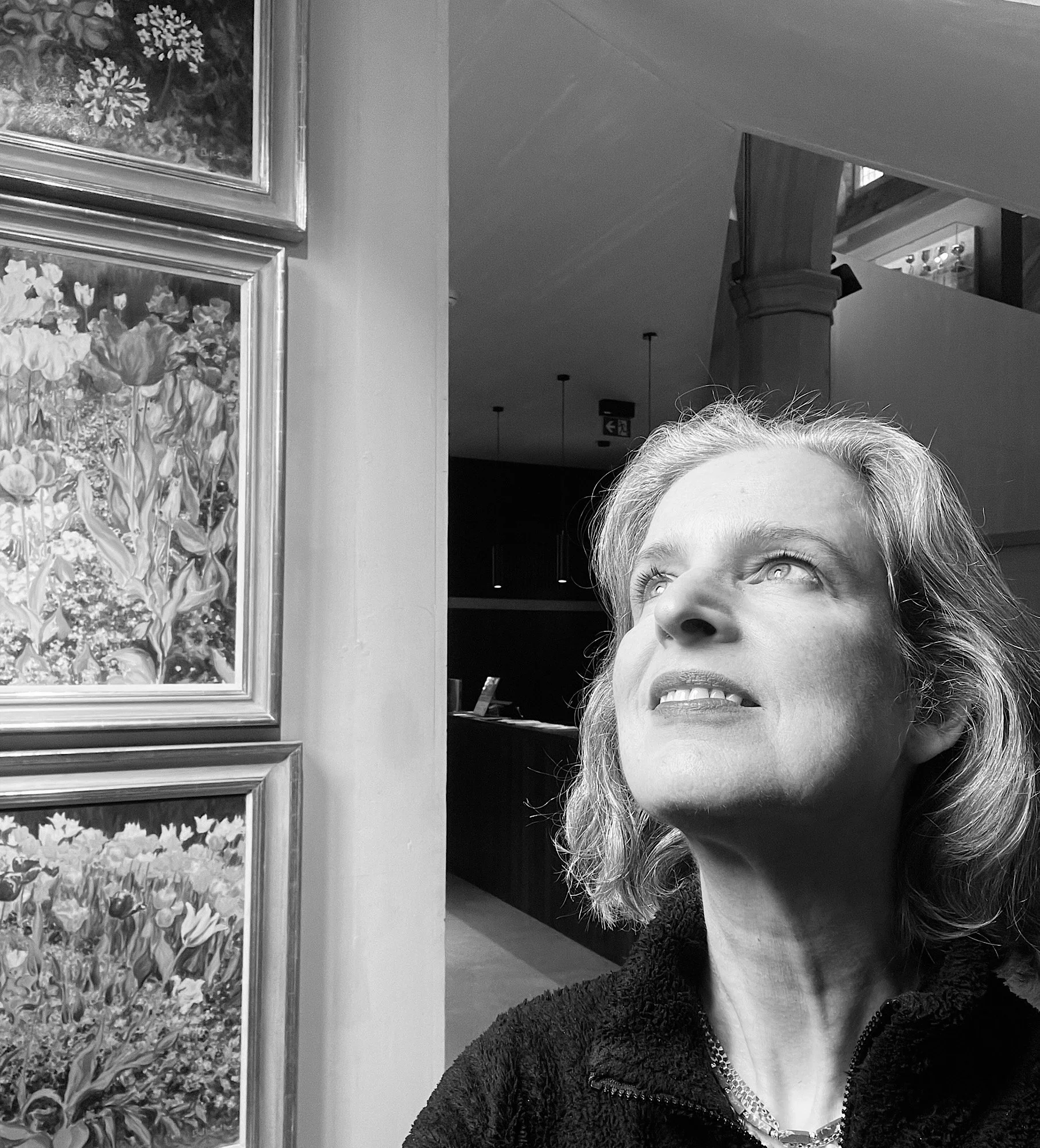Maria Bell-Salter, Fruition, Oil on canvas, 39 x 39 in (100 x 100 cm)
Introduction
by Frances Spalding CBE, FRSL
Flower painting occupies a significant role in the history of art. High points come readily to mind, among them the golden age of Dutch seventeenth-century flower-painting, rich in symbolism; Claude Monet’s pictures of his flower garden at Giverny, especially the some 250 paintings he did of waterlilies during the last thirty years of his life; and Cedric Morris’s wonderfully flamboyant paintings of irises, of which he himself cultivated many bearded varieties. But even though this is a much-populated terrain, Maria Bell-Salter’s flower paintings stand out as having a recognisable style and specific achievement of their own.
Hers is a name to conjure with in this field, partly because her enthusiasm for flowers is accompanied by a cultivated knowledge of art. Central to her education was the study of art history, which she afterwards taught. Key interests at this stage were French Impressionism and English Pre-Raphaelites. In addition, she had a love of nature and landscape. After a while she realised that the urge to paint herself took over from the desire to talk about the art of others. Having looked at many pictures, it did not seem necessary to seek art-school training and she plunged straight in. Eventually she moved to Paris, taking a studio there for seven years. One initial anxiety on setting out on her own was a fear of merely copying others, but this was overcome when she realised that standing on the shoulders of great artists was in fact a help in finding her own artistic personality.
So what is it that makes Bell-Salter’s paintings so rich and pleasurable? First, there is her ability to alter her method according to the season, her subject, or the scale of the picture. This adaptability seems to encourage a vigorous approach, and the spread and reach of the flowers and foliage often covers the full breadth and height of the canvas. This breeds a spirit of generosity and brings us very close to what is portrayed, be it tulips, agapanthus, irises, sunflowers, or hollyhocks. Sometimes a path of forget-me-nots wanders through a dense planting of tulips, or a darker mesh of earth and indeterminate foliage leads us in and around the tall allium stalks holding up delicate but large balls of flowers.
More usually in paintings of this genre, the flowers held up for our gaze are presented as if in another world, separated from us by a different, more pristine existence. But Bell-Salter’s burgeoning flowerbeds seem to invite us in, so that we too can become part of the growth and promise of nature.
About
Maria Bell-Salter, Garden Museum, 2024.
London based, Maria Bell-Salter paints in oils on canvas or linen with the spirit of plein-air painting at the heart of her work. Self-taught as an artist, she has an MA in French and an MA in History Art with a focus on the French Impressionists. It was this path that led her to turn to painting and develop her own style, inspired by a desire to convey the beauty, light and positivity to be found in nature.
She has painted since the mid 1990’s, exhibiting in the United States then moving her studio to Paris, represented by galleries on the prestigious Rue de Seine and Avenue Matignon before returning to London and her English roots. Commissions form a significant part of Maria’s practice and her exuberant paintings of landscapes and herbaceous borders feature in numerous private collections in the UK and internationally, including the United States, Europe and the Far East.
Maria is a founder of ARTscapades; and a Trustee and Steering Committee Chair of the UK Friends of the National Museum of Women in the Arts (NMWA).
Artist statement
The word, Fruition, signifies the realisation or fulfilment of a plan or project, also from the late Middle English it means – to enjoy, to delight in. Gardens, however ‘natural’ they may appear are a product of our own creation, one we have made to bring pleasure to ourselves and others as they mature and bloom.
My paintings of tulip beds and herbaceous borders immerse the viewer in vitality and colour – sometimes strong and vibrant, sometimes subtle with undefined mystery in the depths. Through this, I hope to convey a sense of the inspiration, joy and wonder that I feel at the sight of a garden brought to fruition.
Solo Exhibitions
2024 Garden Museum, London
2023 Gallery Eight, London
2013 Mall Galleries, London
2009 ING Bank, London
2007 ING Bank, London
2001 Galerie de Suede, Nice
1998 Galerie Heraud, Ave. Matignon, Paris
1996 Galerie Heraud, Ave. Matignon, Paris
1994 Botanical Gardens, Memphis
1994 Palmer Gallery, Hot Springs
1993 Malcolm Innes Gallery, London
1992 Botanical Gardens, Memphis
Selected group
Exhibitions
2000
Galerie Heraud, Ave. Matignon, Paris
Paris Art Galerie, Rue de Seine, Paris
1999
Salon des Independants, Paris
Paris Art Galerie, Rue de Seine, Paris
1997
Galerie Heraud, Ave. Matignon, Paris
1995
Galerie Heraud, Ave. Matignon, Paris
Bell Gallery, Memphis
Heinley Fine Arts, Boston
1994
Cadogan Gallery, Draycott Ave, London
1993
Richmond Gallery, Cork St, London
Press
This is gentle yet exuberant art, with colours that sing and that would bring a sense of summer to the viewer on even the coldest day. There is definitely a hint of the French Impressionists and Post-Impressionists here, combined with a 21st-century sensibility that tells us that these images are very much of our own moment.
Frances Follin, Cassone Magazine.
Maria Bell-Salter’s natural grace and gentleness of spirit overflows into her paintings. Her work is free of the harshness and sometimes cynicism that pervades many contemporary art works. (…) Her choice of the typical square canvas, favoured by Monet, lifts these paintings out of the realm of ‘landscape’ to something more immediate and tangible.
Hilary H. Guise, Art historian and critic, London.
...Elle renouvelle la tradition impressioniste, à l’aide d’une technique toute personnelle où la coloure est incandescante. Ses huiles sur toiles sont exaltantes, tant elles chantent la verdoyance de la nature et sa generosite naturelle.
Patricia Trojman, Le Journal de Nice.
(….She renews the Impressionist tradition by means of a personal style in which colour is luminous. Her paintings are exalting and proclaim the verdance and bounty of nature.)
A travers un jeu subtil de touches, de couleurs et de lumières Bell-Salter interprete le visible à sa facon; et sa transposition, pleine de ferveur et de poésie, vient témoigner une nouvelle fois de la délicatesse de son écriture.
Le Courrier des Galleries, Paris.
(Through her subtle play of brushwork, colours and lightning, Bell-Salter interprets the visible in her own way. This conversion, full of fervour and poetry, testifies once again to the sensitivity of her touch.)

